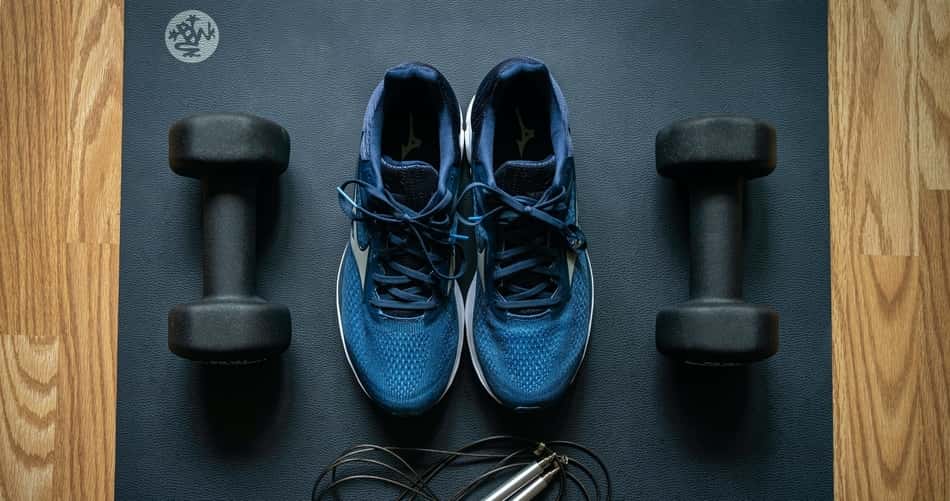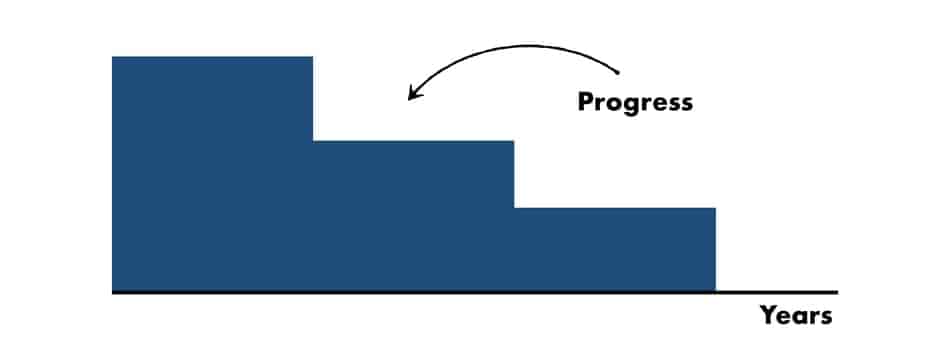Have you ever been in a situation that despite hard work and countless hours in the gym your body seems to look and feel the same this year, as the year before? A staggering amount of people train in the gym without seeing a lot of progress. Wonder why? They seem to do the same type of workouts year-round, without doing progressive overload.
Progressive overload is an important part of the training program because it provides the efficient stimulus for neural adaptations, metabolic and hormonal responses that lead to muscular hypertrophy. Adding more volume progressively over several weeks leads to optimal muscle and strength gain.
On the flip side, training without progressive overload can not only plateau your goals but also waste your precious time. So buckle up because in this article I will explain to you everything there is to know about progressive overload, why is it important, how it works, and give you some ready-made examples.

What Is Progressive Overload?
Let’s kick off by explaining what exactly is progressive overload. In general, progressive overload is defined as adding more volume to your resistance training. Which is quite broad of a term. Does it mean spending more time on the elliptical?
Not really.
Progressive overload is mainly applied to resistance training. This means free weights, machines, and bodyweight exercises. And when we say adding more volume there are several angles to look for. Weight, distance, sets, reps, and time (source).
More weight
Going from 45-pounds to 65-pounds is a progression of weight. Over time, you want to keep on adding more weight to your lifts. Adding more weight doesn’t always mean more plates on the rack. It can also mean the lift you do with your usual weight is getting “lighter”.
This can also mean time under tension. You can stay with the same weight, but going slower with more controlled movement, you have already created enough variety for your muscle to start adapting.
Further distance
If you do any loaded carries, going further than before is progressive overload. Farmers walk, pushing the prowler, or any weighed carry move.
More reps
Adding more reps to your typical workout is another example. Adding extra 5 reps to your set of 10 push-ups or 15 more crunches on the mat all counts.
More sets
Doing the same weight, the same reps but going with more sets is also a indicator of progress. If you want to go even further, more advanced approaches like drops sets or super sets count too. So if you’re adding extra set of leg extensions after your brutal set of squats, that’s a overload right there.
More or less time
Here you have few option because you can work on your training progression simply by reducing the time spend in the gym. This will means you can do shorter rest between the sets to keep your heart rate up.
It can also means keeping the same amount of time but adding more work load. So you work more with the same time.
Why Is Progressive Overload Important?
So now when you know what exactly is progressive overload, you can probably guess that without any of those changes, our body gets used to the training volume, and any initial results plateau. That means you not only gonna see not physical changes, but as time flies, you may even see some decline.
I’ve seen so many people spending their time and effort in the gym doing the same thing over and over with no results. Which is frustrating and discouraging.
But does it means you need to increase the weight each time you check in to the gym? No really.
Progressive overload happens over time. And for beginners, it can feel like heaven because when you just starting to lift, your initial progress goes up like a stock in the bull market. This can happen around the first year or two of lifting (source).
But thanks to our body adaptations, it will slowly start to plateau. With more time in the gym, you will need to think of more advanced techniques to continually challenge your body.

But just because it gets harder it doesn’t mean you should give up. The longer you do strength training, the better your quality of life (source). Decades of studies show that consistent strength training helps with:
- reduce body fat
- increase basal metabolic rate
- decrease blood pressure
- reduce the risk of osteoporosis
- preserve bone density
- improve blood lipid profiles
- improves glucose tolerance and insulin sensitivity
- relieves from pain
Also keep in mind that strength training while being in a calorie deficit is the number one silver bullet to reduce the effects of the metabolic slowdown. During dieting and calorie restriction, our body will try to break down muscle mass to deliver essential amino acids.
This is called muscle protein breakdown. With low protein intake and calorie deficit, we are gonna be losing muscle mass. This can enhance the weight gain after the weight loss.
Can You Do Progressive Overload While Cutting?
Doing progressive overload while cutting helps not only to save the precious lean body mass while keeping the metabolic rate high but also can lead to an increase in muscle mass, even while being in a calorie deficit. This means you don’t need to be on the calorie surplus to gain muscle mass.
In fact, the hypocaloric high-protein diet with regular resistance training is enough to stimulate hypertrophy. Of course, an excessive calorie deficit isn’t optimal for performance. You will feel crashed. Everything will feel so much heavier. It’s just hard to keep going up with training while dieting.
But it can be done. At least for a short period of time.
Progressive Overload Workout Plan For Calorie Deficit
Finally, here I will show you the simplest way to create your own progressive overload in the most efficient way. Bear in mind that not all exercises are created equal.
I typically like to do a full-body workout each time I’m in the gym. This way I don’t beat myself up and I don’t need to stress about missing a day or a body part if I can’t get to the gym.
The most effective exercises will include compound movements. These multi-joint exercises are great not only to stimulate more muscle fibers but also more neural adaptations. This means your whole CNS is getting involved.
Week 1-4
In the first month, you want to focus on the proper form. The most important part of the training is to be able to do wokrouts while being pain-free.
When you feel muscle or joint pain during your exercise, this pain signal shuts down the muscle activation. You not only don’t get any benefit from the lift, but you can also hurt yourself.
So focus first on those 4 basic movements.
| Squats | 3 sets 10 reps |
| Bench press | 3 sets 10 reps |
| Deadlift | 3 sets 10 reps |
| Overhead press | 3 sets 10 reps |
Focus on things like:
- Full range of motion
Until you won’t be able to squat below parallel with the knees, I wouldn’t worry about adding more weight. If you struggle to keep your back in a neutral position while doing deadlifts, then adding more weight won’t fix the problem. If you cannot fully extend your arm overhead because of the kyphotic posture then forget about more weights.
- Slow controlled movement
This is not a “need for speed” or CrossFit games. This is you getting your form right. Leave your ego in the locker room, do each move slowly, without beings rushed. It will pay you in spades.
- Muscle activation
The whole point of doing move slowly you want to feel the muscle gets fatigued. I used to do push-ups like a maniac without even paying attention to my form, and as a result, I’ve jacked my shoulders, because I didn’t put emphasis on the pecs.
Week 5-8
Here we already know your form is better. You can do each exercise without any problems and you find yourself being even slightly stronger. Now you want to add more volume. This may mean you add extra reps or set or more weight into the table.
It can also mean you just stay as it is and add an additional day of work. So if you’ve been doing 3 days in the gym, now is time to ramp up to 4-5 times a week.
Here is the example of a breakdown for adding extra training day and making some variety
Workout A
Monday and Thursday
| Squats | 3 sets 10 reps |
| Bench press | 3 sets 10 reps |
| Deadlift | 3 sets 10 reps |
| Overhead press | 3 sets 10 reps |
Workout B
Tuesday and Saturday
| Front squats | 3 sets 10 reps |
| Pull-ups | 3 sets 10 reps |
| Kettlebell Swings | 3 sets 10 reps |
| Overhead press | 3 sets 10 reps |
So by adding an extra day to your existing training time, you’re already doing progressive overload. Obviously with new exercises, you want to make sure your form is in place, too.
Week 9-12
Now once Your body gets used to training intensity, and we cannot really push for more days in the week, it is time to add more volume by ramping up the weight or sets. Here is an example of how you can manage that.
Workout A
Monday and Thursday
| Squats | 4 sets 10 reps |
| Bench press | 4 sets 10 reps |
| Deadlift | 4 sets 10 reps |
| Overhead press | 4 sets 10 reps |
So by adding the additional set for each exercise we actually end up with 80 reps of each exercise, instead of 60 reps within one week.
Another way you can look at it is by lowering the reps but adding more weight and sets to the exercise. This will impact your muscles from a different angle and focus more on strength, rather than size.
Workout B
Tuesday and Saturday
| Front squats | 5 sets 5 reps |
| Pull-ups | 5 sets 5 reps |
| Kettlebell Swings | 5 sets 5 reps |
| Overhead press | 5 sets 5 reps |
Rinse and repeat.
Don’t forget that 80% of the effective results are due to a well-balanced diet. To learn more about how to get into a calorie deficit, check out my article here.
Conclusion
There is a reason why progressive overload is the most important part of any strength training. It works. Especially when being on a calorie deficit. It will help you get better results and make sure you’re burning fat, not muscle.
